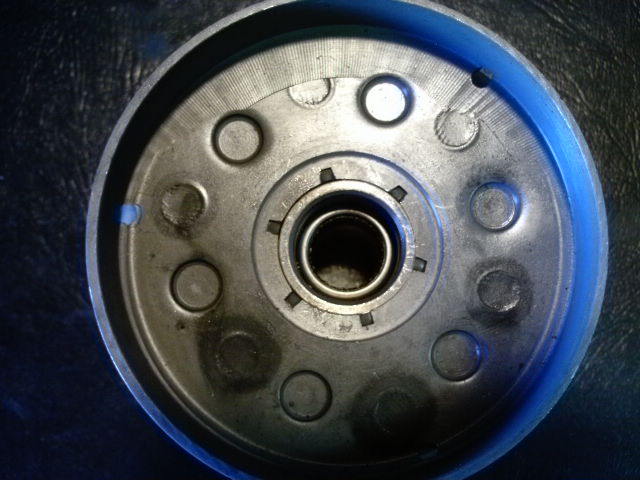The Tomos two-speed automatic dual clutch drum, located behind the bulge in the right side of the transmission cover, is about 4 inches in diameter and made of two stamped sheet steel drums crimped onto a center tool steel precision shaft with gear. In the picture below, the view is of the outboard side, which is the first speed centrifugal clutch side. Flip it over and you would see an identical drum, facing opposite, with a small 1 inch straight-cut gear, the “first speed driving gear”, attached to the inboard side of the dual clutch drum, which is the second speed centrifugal clutch drum.
These drums can be made slightly out of round. They are machined on the inner surface only, where the clutch shoes slip and grab, according to speed. That machining is always perfect, as the inside surface is perfectly concentric with the one-way needle bearing. The proof is there is never any rapid pulsation during clutch slip. So the drum and clutches function perfectly. When the outer surfaces are out of round, the whole bike vibrates or buzzes, and gets worse when the engine is revved up going fast. That buzzing can be felt most in the hands and feet. It can make the mirrors blurry. It can make the speedometer go wild. It can make things on the bike crack, break off, or come loose.
When the drum is a little off balance, and the set of three clutch shoes is also a little off balance, then the vibration felt in the bike can become worse at times, more or less at random. This is because every time the bike slows down, the centrifugal clutches let go of the drum as the spring pulls them inward, and they begin to rotate inside the drum. Then when the bike speeds back up the clutches fly out and grab the drum, because of centrifugal force. But they end up in a new random location in the drum. If the heavy side of the clutch is opposite the heavy side of the drum, then there will be minimum vibration. If both heavy sides are together, there will be the most imbalance and the maximum vibration felt.
Other things can cause excessive engine vibration. Installing a heavier or bigger piston, like a 65cc, is the most common. Running with a loose flywheel or clutch nut is one. The magneto flywheels all seem to be balanced good, although they have not been tested. Using mis-matched clutch shoes is another. Not only should they all weigh the same, but they should all be equal in wear, not one new and two worn out, for example.
Above, the Tomos clutch drum. This one is extremely out of round, so bad you can see it with your eyes. Look at the thick wall on the left. Now compare that with the thin wall on the right side. Clearly the left side is heavier! When they’re bad they’re usually less than half this much. The out of balance clutches began around 2008. Before that, from 1976 to 2007 there was never any noticeable balancing or vibration problem. The A35 (1991-2006) and A55 (2002-later) have the same clutch drum. The A3 (1976-1990) one looks the same but parts of it are smaller or thinner.
Pressed into the center of the clutch drum is a precision roller clutch, a needle bearing that only turns one way. In the picture below, the roller clutch is installed correctly, with the plain side facing out, and the writing side facing inward. When you rotate an installed Tomos clutch drum clockwise, it engages the crankshaft. When you rotate it counter-clockwise, it spins free. When a Tomos engine seizes or hydraulics (that’s when the piston slams into incompressible liquid – gas or oil), the roller clutch can become damaged. It usually becomes tight or frozen. When a Tomos roller clutch is frozen, the bike will run fine but won’t go into neutral when you slow down to stop.
How to “balance” the drum:
A machine shop or a home machinist with a lathe, can perform a precision cutting operation. The drum is held by it’s inner surface, and turned in a lathe. The high parts of the outer surface are “skimmed off”. Try to leave the lowest part uncut, to give it the most strength.
